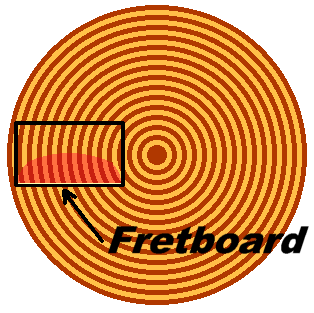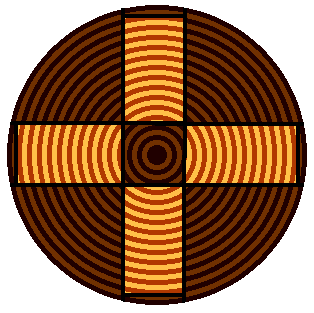TOCCover Contents Preface Terms Design Materials Construction Appendex Next |
General supplies.White Berol Prismacolor pencils.Rags and paper towels. Emery and sand papers, w/grits small as 1000. White glue (to glue the sandpaper.) Ethyl cyanoacrylic glue. Accelerator (for glue above.) Acetone (solvent for glue.) End Mills (square, round and radius.) Sanding drums Fostner bits Drill bits Micro cut-off wheels. Sanding drums. Masking tape. Drafting supplies and paper. Enron (2-part polyurethane.) Solder Electrical tape Shrink tubing (for wires) Tools.Spray gun.Compressor. Soldering iron. Vertical milling machine. Rotary table. Swivel vice. Lathe (metal lathe). Sanders. Dial caliper. Band saw. Electronic parts.MIDI hex pickup.[Shadow pt. no. ] Potentiometers (100K.) [6 x Mouser pt. no. 594-248-7104] Potentiometers (100K, must be ganged and the shaft shortend after purchase.) [4 x Mouser pt. no. 594-148-7104] Switch (12 pole two position rotary.) [Mouser pt. no. 10WR122] Miscellanous parts.Hannabach high tension classic guitar strings.Copper foil (adhesive backed.) Wire (copper with stranded core.) German Silver fret wire. Gilbert Tuners (Black w/ green abalone dot, black rollers, and ebony knobs). I believe John Gilbert makes the best tuner. (He told me that he once was chief tooling engineer for Hewlett Packard.) The headstock is designed with them in mind. If you choose other tuners, be cautious and check your dimensions as you may need to redesign the headstock to accommodate your tuners. Again, it is recommended these tuners be used for a luthier's first building of this instrument so that they will have a functional working model for reference when later building custom versions.Wyoming jade nut (Old jade, Nephrite, dark green) Old jade is nepherite, and seemed perfect for making a nut of. Substitute ox bone if you wish, or visit a rock hound and ask about Wyoming jade (the DARK green kind is sometimes almost black, and is the kind you want, not the light colored jade which is a different mineral even though also called jade.) Paua Abalone laminate (green) Aluminum plate stock (7075 series) Screw inserts (for back plate area.) Hex bolts (to hold in the back plate.) Binding (back ) Binding (green) Woods.Cocabolo[neck] Select this piece with care, it is the heart of this instrument. Choose wood that has had time to dry and reach an equilibrium with your local humidity. Freshly cut wood may tend to warp as it dries and this would be disastrous if it warps after being made into a neck. The wood I selected had been drying for several years thus, any warping (which is the strain caused by the stress created from an uneven drying), has already taken place before I begin squareing the stock. This same piece will also become your headstock and fingerboard. Grain should run
the length of the board and the individual layers of wood should
also run from front to back of the neck. Grain should run
the length of the board and the individual layers of wood should
also run from front to back of the neck.This will result in your neck having the greatest strength possible in support of the strings, and the least bending of the neck. (This is opposite of the desired effect of an archers bow from which stringed instruments originated and where flex is desireable.)  Here is a cross section of how this piece may have been cut from the log, and how four pieces may be cut from a single log. Square the board true by machining all four sides and both ends. One face of this board will be the face of the fingerboard portion of the neck and should be treated respectfully so as to avoid scaring it through the processes. If a laminated headstock is desired or required (due to the available lumber sizes,) Then machine the surfaces to be joined, glue them, and then machine the stock back to square. For Cocabolo wood I use acetone to help clean the wood before joining with (ethyl) cyanoacrylic glue and waiting several days before unclamping. [knobs] (1 switch, 2 master, 6 small) [switch cover] Cocabolo is a dangerous wood to work with (it is an irritant and I have seen people get physically ill from breathing its dust. Wear a dust mask.) Yet is responsible for the incredible sustain of this instrument. The neck is unusual in being made of this wood as opposed to the normal light woods used. While it may be possible to substitute another material, it is recommended this material be selected based upon it's specifications compared directly with that of Cocabolo. Wenge[back and sides]Wenge is a hard wood with a rough mahogany like texture and composed of light chocolate brown and black alternating in the tight grain pattern. it is: brittle, porous, easily splintered, hard, and has the density of ebony, but it looks good. I found that filling the wood with CA helped a bit but generates fumes if too hot from cutting. Spruce[top]Spruce was chosen more for it's traditional look than for any other reason. Cedar is also accepted as a material for tops, but most other woods are not, and a strong wood, light of weight and color, is recommended. It may be necessary to laminate some of your wood pieces to obtain large enough (composite) pieces before cutting to size. Pre-machine (cut) these smaller pieces before gluing to form the larger pieces. Pay attention to the matching of grain patterns and the squareness of your cuts, then use a glue recommended for that type of wood. All raw wood is assumed to have been purchased just a bit over sized and then machined (cut, sanded,) to the sizes indicated. It is wise to begin with stock which has been squared and sized as you may later wish to rely on measurements taken directly from these surfaces, so it can be extremely important to purches wood larger than the dimensions above and using your best craftsmanship prepare them to exactly the dimensions above as if this were the goal of your work. |